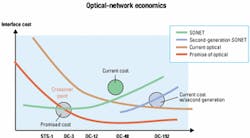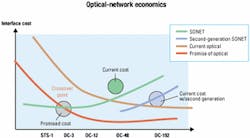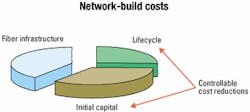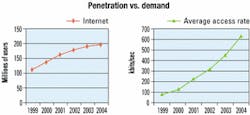Telecom network economics: how to achieve profitability
Profitability will require development of a fully integrated optical network to deliver wavelength transport, distributed crossconnect, and routing from a single architecture.
BIJAN KHOSRAVI and SOPHIA FANG, Movaz Networks
Given the new Wall Street economic factors, the only criterion that matters to Wall Street now is profitability. The profitability equation for service providers is simple: minimize costs and maximize revenues. The reality of achieving profitability is another story.
To understand this story, we must turn back the clock. In 1996, a new company debuted with a new generation of DWDM optical transport equipment. That is different from SONET in that it is meant to be all-optical. The theory is that optical-electrical-optical (OEO) conversion, as done in a SONET multiplexer, is costly. Furthermore, electrical equipment has a much shorter depreciation cycle compared to optical. If we can move to an all-optical network, the equivalent costs of providing wavelengths for interfaces such as OC-3 (155 Mbits/sec), OC-12 (622 Mbits/sec), OC-48 (2.5 Gbits/sec), and even OC-192 (10 Gbits/sec) would decrease by as much as 50%. That promise quickly resonated among all vendors.
The only problem was that the promised cost benefits never materialized for service providers. First-generation SONET equipment is still more economical to deploy than all-optical equipment providing wavelengths for service interfaces at and below the OC-48 rate. To make matters worse, second-generation SONET equipment, introduced in 1999, has moved the yardstick even further out. Now, the cost of wavelength transport is only marginally better at the OC-192 rate compared to SONET.It is no wonder then, while optical equipment carrying OC-48s and OC-192s was being installed in long-haul networks, that service providers serving the access, metro, and even some regional networks struggle to make sense of the higher costs of wavelength-based services. After all, of the three cost components associated with building a network-initial capital costs, lifecycle costs, and infrastructure costs-only the capital equipment and lifecycle costs can be controlled.
Service providers find that not only have equipment costs remained high, the operational costs have also risen considerably due to the inefficiencies of having to build overlay networks. Overlay networks had to be built either to achieve connectivity in linking customer buildings from originations to destinations or in providing new types of services, such as Gigabit Ethernet. Overlay networks can take more than a year to build, resulting in a year of capital expenditure with no revenues-which leads right back to why the profitability equation is easy to look at on paper, but not so easy to achieve with today's networks.
To maximize margins, service providers are either holding back demands or implementing short-term low-cost solutions that are not evolvable. These measures have, in turn, triggered the general downturn of the equipment provider industry. Until the costs of wavelengths can be dramatically reduced and it is economical to deliver gigabit services at the same cost as an STS-1 (52 Mbits/sec) in a SONET-based network, high-bandwidth services will remain on a slow ramp to achieve wide penetration, especially to desktop users.With Internet access penetration reaching a plateau and its growth flattening out, the next big demand will only come when access rates increase from the current dial-up speeds to megabit or gigabit rates. That will only happen if the economics of providing those rates can be justified in the profitability equation of service providers.
To open up the demand again, service providers must aggressively move toward a network with redefined economics. What does it take to build such a network? Can it be done with today's technology from well-established vendors?
It appears unlikely that building a cost-effective, wavelength-based network with today's available technologies and architectures is even possible. The key ingredients required must be embedded into the product architecture from day one. If that is not so, service providers will forever be patching pieces of different technologies together in various forms and, in so doing, driving up the end costs.
The new wavelength-based networks must deliver low cost and high bandwidth to every user for every usage, with minimum operational requirements and constraints. The necessary ingredients for achieving this end goal include:
- Cost-effective optical transport that provides high bit rates with extended reach.
- Distributed wavelength crossconnect functionality, which is built into every optical-network element, just like the embedded STS-1 crossconnect functionality in SONET.
- Intelligent lambda routing capabilities and end-to-end wavelength provisioning for simplified and dynamic wavelength management.
There is no doubt that these ingredients represent three distinct technologies. The challenge is not in developing each piece or in acquiring the pieces just to complete a product portfolio. Having separate boxes, one for each function, only leads to multiple times the costs, not to mention the need for external operation support system (OSS)-level integration. The challenge for equipment vendors is in how to best integrate all three technologies into a single platform with minimum footprint and optimized cost structure.
The integration of these technologies is actually multidimensional. At the product level, it requires hardware and software integration; at the functional level, wavelength transport and switching integration; and at the system level, end-to-end signaling and control integration with end-to-end optical networking.
In this architecture, advanced optical transport must be capable of carrying 80 to 160 wavelengths at 2.5-Gbit/sec, 10-Gbit/sec, or even 40-Gbit/sec rates to deliver the high-speed pipes needed for the next wave of data services such as 10-Gigabit Ethernet. It must also terminate hundreds of wavelengths from a single bay to avoid costly, stacked multistaged terminations. Amplification must be built in to achieve several-hundred- kilometer reach. Power equalization must be automatic so no truck rollout is necessary every time a wavelength is added. Additionally, the cost of optical transport must be reduced by a factor of two or three for it to be mass-deployed in the access and metro networks.The switching element, which literally becomes the brain of the transport element, must be true optical-to-optical. True optical does not mean the implementation of first-generation optical crossconnects (OXCs) that still require OEO conversions and present huge fiber management problems. These OXCs require three to eight bays to house 500 to 1,000 ports, all of which must be manually fiber-connectorized. That not only requires extensive installation costs up front, but also ongoing maintenance costs in tasks such as connector cleaning.
Next-generation photonic-switching technology must not be just a large semi-intelligent optical patch panel like first-generation OXC. It must be designed to provide the following benefits:
- Reduction of fibers that must be externally interfaced from several hundreds to tens.
- Elimination of OEO conversions where multiplexing/demultiplexing is done using free-space optics to reduce the need for costly electronics and meet millisecond switching time, even in network restorations of complex meshed configurations.
- Scaling the wavelength crossconnect matrix using three-dimensional micro-electromechanical system (MEMS) technology to expand flexibly without scaling the size of the crossconnect itself.
The added benefit of integrating and housing the wavelength crossconnect within the same transport element is that the wavelength crossconnect functionality becomes essentially distributed across the network. This approach, as compared with the centralized OXC design, allows wavelengths to be locally routed and terminated without having to be back-hauled to the centralized location, only to be transported back again.
The lambda routing capability is critical from an operations and management perspective. With thousands of wavelengths being transported and switched, there must be a mechanism to tag, route, and monitor each wavelength without users having to manually track the comings and goings of wavelengths.
Since the packet network has evolved to a set of standard protocols, it is only natural to look at how to adopt the same routing algorithms for use in optical networks. That has led to the development of Multi protocol Lambda Switching (MPlS), which treats wavelengths al most like packets. It allows intelligence to be wrapped around each wavelength for dynamic reconfiguration without manual intervention.
The routing tables that eliminate the extensive external configuration database maintenance requirements of today are contained in each network element. That is also absolutely critical for mesh restoration if millisecond-switching time is to be maintained.
Each technology described here is al ready a vast improvement over today's available optical equipment. However, the true power comes when these three technologies are elegantly combined into a single element that can intelligently transport and crossconnect thousands of wavelengths from anywhere in the network to anywhere else in the network-at a cost that is orders of magnitude cheaper than deploying separate technologies and separate boxes.
With this fully integrated all-optical element, the network picture is now drastically simplified. There are wavelengths and there are services. There is no need to map services to SONET, SONET to wavelengths, wavelengths to electrical signals, and back to wavelengths again. The cost advantages are self-explanatory.
From a network application perspective, the beauty of mapping services directly into wavelengths is that service providers can now put in a high-speed pipe to the customer at a flat cost, regardless of bit rate. Customers can be provisioned with a 10-Mbit/sec service on day one and scale to 10 Gbits/sec without the service providers having to build overlays or deploy additional equipment. That's the only way to enable bandwidth on demand and shorten waits for service provisioning.
Emerging business service carriers have already caught on. They are making available 100-Mbit/sec Ethernet services at about $1,000 per month, which is similar to the price point of a DS-1 (1.55-Mbit/sec) service today. There is no need to guess which way the customer selection will be. It is these economics that will accelerate the bandwidth demands in the network again and drive service-provider revenues.
Profitability for service providers is absolutely achievable. It just requires a different approach to building the networks of today. The new approach required is the development of a fully integrated optical-network element, which will deliver wavelength transport, distributed crossconnect, and routing-all from the same architecture.
With this architecture, new services can be activated at the click of a mouse once the wavelength route is established. Revenues can be collected within days of the customer orders. The profitability equation of minimizing costs and maximizing revenues will finally be within service providers' grasps.
Bijan Khosravi is CEO and Sophia Fang is vice president of business development at Movaz Networks (Norcross, GA). They can be reached at the company's Website, www.movaz.com.



